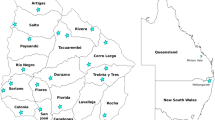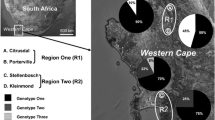Abstract
We studied the genetic structure of Mycosphaerella cryptica following natural infection of Eucalyptus globulus in a genetic trial. Results from this study indicated significant genetic variation within, and between, E. globulus families (three cloned and control-crossed F2 and four open-pollinated families). Single-ascospore isolates were sampled from 72 E. globulus trees with contrasting levels of resistance within the trial, 21 E. nitens trees in an adjacent plantation, and five distant Eucalyptus plantation trees (two E. globulus 100–2400km; two E. nitens 50–2200 km; one E. grandis × E. tereticornis hybrid 1500 km from the trial). Deoxyribonucleic acid from these isolates was scored for the presence/absence of 75 random amplified polymorphic DNA (RAPD) loci. Only 18 RAPD genotypes, which appeared to recombine rarely, were present among the 98 isolates, which indicates that M. cryptica is not strictly heterothallic. Cluster analysis using genetic distance revealed that M cryptica genotypes from the field trial grouped into two clusters that matched differences in isolate culture morphology, indicating that the fungal population comprised two distinctive biotypes. The two biotypes differed markedly in their host interactions. Biotype 2 was found only on E. globulus, whereas biotype 1 infected both E. globulus and E. nitens eucalypt species. Within E. globulus, biotype 2 was almost exclusively collected on resistant trees whereas biotype 1 was found on both resistant and susceptible trees. The hypothesis that there could be specialisation of M cryptica biotypes occurring at two levels, among host species and within host species, is discussed.
Similar content being viewed by others
References
Adhikari TB, Anderson JM, Goodwin SB (2003) Identification and molecular mapping of a gene in wheat conferring resistance to Mycosphaerella graminicola. Phytopathology 93, 1158–1164.
Agapow P-M, Burt A (2001) Indices of multilocus linkage disequilibrium. Molecular Ecology Notes 1, 101–102.
Backman PA, Landschoot PJ, Huff DR (1999) Variation in pathogenicity, morphology, and RAPD marker profiles in Colletotrichum graminicola from turfgrasses. Crop Science 39, 1129–1135.
Ballantyne B, Thomson F (1995) Pathogenic variation in Australian isolates of Mycosphaerella graminicola. Australian Journal of Agricultural Research 46, 921–934. doi: 10.1071/AR9950921
Brading PA, Verstappen ECP, Kema GHJ, Brown JKM (2002) A gene-for-gene relationship between wheat and Mycosphaerella graminicola, the Septoria tritici blotch pathogen. Phytopathology 92, 439–445.
Calenge A, Faure A, Goerre M, Gebhardt C, Van de Weg WE, Parisi L, Derel C-E (2004) Quantitative trait loci (QTL) analysis reveals both broad spectrum and isolate-specific QTL for scab resistance in apple progeny challenged with eight isolates of Venturia inequalis. Phytopathology 94, 370–379.
Campbell GF, Crows PW, Lucas JA (1999) Pyrenophora teres f. maculata, the cause of Pyrenophora leaf spot of barely in South Africa. Mycological Research 103, 257–267. doi: 10.1017/S0953756298007114
Carnegie AJ, Ades PK (2002) The proportion of leaf spots caused by Mycosphaerella cryptica and Mycosphaerella nubilosa on Eucalyptus globulus, E. nitens and their Fl hybrids in a family trial in Tasmania, Australia. Australian Mycologist 21, 53–63.
Carnegie AJ, Ades PK (2003) Mycosphaerella leaf disease reduces growth of plantation-grown Eucalyptus globulus. Australian Forestry 66, 113–119.
Carnegie AJ, Ades PK, Ford R (2001) The use of RAPD-PCR analysis for the differentiation of Mycosphaerella species from Eucalyptus in Australia. Mycological Research 105, 1313–1320.
Carnegie AJ, Ades PK, Keane PJ, Smith IW (1998) Mycosphaerella diseases of juvenile foliage in a eucalypt species and provenance trial in Victoria, Australia. Australian Forestry 61, 190–194.
Carnegie AJ, Keane PJ (1998) Mycosphaerella vespa sp. nov. from diseased Eucalyptus leaves in Australia. Mycological Research 102, 1274–1276. doi: 10.1017/S0953756298006431
Carnegie AJ, Keane PJ, Ades PK, Smith IW (1994) Variation in susceptibility of Eucalyptus globulus provenances to Mycosphaerella leaf disease. Canadian Journal of Forest Research 24, 1751–1757.
Chen R-S, McDonald BA (1996) Sexual reproduction plays a major role in the genetic structure of populations of the fungus Mycosphaerella graminicola. Genetics 142, 1119–1127.
Crous PW (1998) Mycosphaerella spp. and their anamorphs associated with leaf spot diseases of Eucalyptus. The Mycological Society of America. Mycological Memoir No. 21. (APS Press: St Paul, Minnesota)
Crous PW, Aptroot A, Kang JC, Braun U, Wingfield MJ (2000) The genus Mycosphaerella and its anamorphs. Studies in Mycology 45, 107–121.
Crous PW, Carnegie AJ, Keane PJ (1995) IMI descriptions of fungi and bacteria, Set 124. Mycosphaerella cryptica. Mycopathologia 130, 43–46. doi: 10.1007/BF01104349
Crous PW, Groenewald JZE, Gams W (2003) Eyespot of cereals revisited: ITS phylogeny reveals new species relationships. European Journal of Plant Pathology 109, 841–850. doi: 10.1023/A:1026111030426
Crous PW, Groenewald JZ, Mansilla JP, Hunter GC, Wingfield MJ (2004) Phylogenese reassessment of Mycosphaerella spp. and their anamorphs occurring on Eucalyptus. Studies in Mycology 50, 195–214.
Crous PW, Hong L, Wingfield BD, Wingfield MJ (2001a) ITS rDNA phylogeny of selected Mycosphaerella species and their anamorphs occurring on Myrtaceae. Mycological Research 105, 425–431. doi: 10.1017/S0953756201003835
Crous PW, Kang JC, Braun U (20016) A phylogenetic redefinition of anamorph genera in Mycosphaerella based on ITS rDNA sequence and morphology. Mycologia 93, 1 OS 1 — 1 101.
Dick M A, Dobbie K (2001) Mycosphaerella suberosa and M. intermedia sp. nov. on Eucalyptus in New Zealand. New Zealand Journal of Botany 39, 269–276.
Douhan GW, Peever TL, Murray TD (2002) Multilocus population structure of Tapesia yallundae in Washington State. Molecular Ecology 11, 2229–2239. doi: 10.1046/J.1365-294X.2002.01607.x
Dungey HS, Potts BM, Carnegie AJ, Ades PK (1997) Mycosphaerella leaf disease: genetic variation in damage to Eucalyptus nitens. Eucalyptus globulus, and their F 1 hybrid. Canadian Journal of Forest Research 27, 750–759. doi: 10.1139/cjfr-27-5-750
Eyal Z, Amiri Z, Wahl I (1973) Physiological specialisation of Septoria tritici. Phytopathology 63, 1087–1091.
Freeman S, Katan T, Shabi E (1998) Characterisation of Colletotrichum species responsible for Anthracnose diseases of various fruits. Plant Disease 82, 596–605.
Ganapathi A, Corbin JB (1979) Colletogloeum nubilosum sp. nov, the imperfect state of Mycosphaerella nubilosa on Eucalyptus in New Zealand. Transactions of the British Mycological Society 72, 237–244.
Guerin F, Cam BL (2004) Breakdown of the scab resistance gene Vf m apple leads to a founder effect in populations of the fungal pathogen Venturia inaequalis. Phytopathology 94, 364–369.
Hammond-Kosack KE, Jones JDG (1994) Incomplete dominance of tomato Cf genes for resistance to Cladosporium fulvum. Molecular Plant-Microbe Interactions 7, 58–70.
Harrington TC, McNew DL (1997) Self-fertility and uni-directional mating-type switching in Ceratocystis coerulescens. Current Genetics 32, 52–59. doi: 10.1007/s002940050247
Jacobson DJ (1995) Sexual dysfunction associated with outcrossing in Neurospora tetrasperma, a pseudohomothallic ascomycete. Mycologia 87, 604–617.
Jones TH, Potts BM, Vaillancourt RE, Davies NW (2002) Genetic resistance of Eucalyptus globulus to autumn gum moth defoliation and the role of foliar waxes. Canadian Journal of Forest Research 32, 1961–1969. doi: 10.1139/x02-l 18
Lucas JA, Bowyer P, Andreson HM (Eds) (1999) ‘Septoria on cereals: a study of pathosystems.’ (University Press: Cambridge)
Lundquist JE, Purneil RC (1986) Provenance variation of Eucalyptus nitens on the Eastern Transvaal Highveld in South Africa. South African Forestry Journal 138, 23–31.
Lundquist JE, Purneil RC (1987) Effects of Mycosphaerella leaf spot on growth of Eucalyptus nitens. Plant Disease 71, 1025–1029.
Mainwaring HR, Wilson IM (1968) The life cycle and cytology of an apomictic Podospora. Transactions of the British Mycological Society 51, 663–677.
Maynard Smith J, Smith NH, O’Rourke M, Spratt BG (1993) How clonal are bacteria? Proceedings of the National Academy of Sciences of the United States of America 90, 4384–4388.
McDonald WC (1963) Heterothallism in Pyrenophora teres. Phytopathology 53, 771–773.
McKinnon GE, Steane DA, Potts BM, Vaillancourt RE (1999) Incongruence between chloroplast and species phylogenies in Eucalyptus subgenus Monocalyptus. American Journal of Botany 86, 1038–1046.
Milgate AW, Potts BM, Joyce K, Mohammed C, Vaillancourt RE (2005) Genetic variation in Eucalyptus globulus for susceptibility to Mycosphaerella nubilosa and its association with tree growth. Australasian Plant Pathology 34, 11–18.
Milgate AW, Yuan ZQ, Vaillancourt RE, Mohammed C (2001) Mycosphaerella species occurring on Eucalyptus globulus and Eucalyptus nitens plantations of Tasmania, Australia. Forest Pathology 31, 53–63. doi: 10.1046/j.l439-0329.2001.00222.x
Milgroom MG (1996) Recombination and the multilocus structure of fungal populations. Annual Review of Phytopathology 34, 437–177.
Milgroom MG, Fry WE (1997) Contributions of population genetics to plant disease epidemiology and management. Advances in Botanical Research 24, 1–30.
Milgroom MG, Peever TL (2003) Population biology of plant pathogens. Plant Disease 87, 608–617.
Mohammed C, Wardlaw T, Smith A, Pinkard E, Battaglia M, Glen M, Tommerup I, Potts BM, Vaillancourt RE (2003) Mycosphaerella leaf diseases of temperate eucalypts around the Southern Pacific Rim. Paper presented at the 8th International Congress of Plant Pathology, 2–7 February 2003, Christchurch, New Zealand. New Zealand Journal of Forestry Science 33, 362–372.
Nelson MA (1996) Mating systems in ascomycetes: a romp in the sac. Trends in Genetics 12, 69–74. doi: 10.1016/0168-9525(96)81403-X
Park RF (1984) The taxonomy, pathology and epidemiology of Mycosphaerella species associated with leaf diseases of Eucalyptus in Australia. PhD Thesis, La Trobe University, Victoria, Australia.
Park RF, Keane PJ (1982a) Three Mycosphaerella species from leaf diseases of Eucalyptus. Transactions of the British Mycological Society 79, 95–100.
Park RF, Keane PJ (19826) Leaf diseases of Eucalyptus species associated with Mycosphaerella species. Transactions of the British Mycological Society 79, 101–115.
Park RF, Keane PJ (1987) Spore production by Mycosphaerella species causing leaf diseases of Eucalyptus. Transactions of the British Mycological Society 89, 461–470.
Park RF, Keane PJ, Wingfield MJ, Crous PW (2000) Fungal diseases of Eucalyptus foliage. In ‘Diseases and pathogens of eucalypts’. (Eds PJ Keane, GK Kile, FD Podger, BN Brown) pp. 153–240. (CSIRO: Melbourne)
Peever TL, Canihos Y, Olsen L, Ibanez A, Liu Y-C, Timmer LW (1999) Population genetic structure and host specificity of Alternaria spp. causing brown spot of Minneola tangelo and rough lemon in Florida. Phytopathology 89, 851–860.
Peever TL, Olsen L, Ibanez A, Timmer LW (2000) Genetic differentiation and host specificity among populations of Alternaria spp. causing brown spot of grapefruit hybrids in Florida. Phytopathology 90, 407–414.
Rayner RW (1970) A mycological colour chart.’ (CMI and British Mycological Society: Kew, Surrey, England)
Rau D, Brown AHD, Brubaker CL, Attene G, Baimas V, Saba E, Papa R (2003) Population genetic structure of Pyrenophora teres Drechs. the causal agent of net blotch in Sardinian landraces of barely (Hordeum vulgareL.). Theoretical and Applied Genetics 106, 947–959.
Robertson SJ, Bond DJ, Read ND (1998) Homothallism and heterothallism in Sordaria brevicollis. Mycological Research 102, 1215–1223. doi: 10.1017/S0953756298006297
SAS Institute (1997) ‘SAS/STAT software: changes and enhancements through Release 6.12.’ (SAS Institute: Cary, NC)
Sokal RR, Rohlf FJ (1995) ‘Biometry: the principals and practice of statistics in biological research’. 3rd edn. (Freeman and Company: New York)
Taylor JE, Groenewald JZE, Crous PW (2003) A phylogenetic analysis of Mycosphaerellaceae leaf spot pathogens of Pro te ace ae. Mycological Research 107, 653–658. doi: 10.1017/ S0953756203007950
Van Zyl LM, Coutinho TA, Wingfield MJ, Pongpanich K, Wingfield BD (2002) Morphological and molecular relatedness of geographically diverse isolates of Coniothryium zuluense from South Africa and Thailand. Mycological Research 106, 51–59. doi: 10.1017/S0953756201005093
Weir TL, Huff DR, Christ BJ, Romaine CP (1998) RAPD-PCR analysis of genetic variation among isolates of Alternaria solani and Alternaria alterna ta from potato and tomato. Mycologia 90, 813–821.
Wingfield MJ, Crous PW, Peredo HL (1995) Foliar pathogens of Eucalyptus spp. in Chile. South African Forestry Journa1 173, 53–57.
Zhang JX, Fernando WGD, Xue AG (2003) Virulence and genetic variability among isolates of Mycosphaerella pinodes. Plant Disease 87, 1376–1383.
Zhan J, Kema GHJ, McDonald BA (2004) Evidence for natural selection in the mitochondrial genome of Mycosphaerella graminicola. Phytopathology 94, 261–267.
Zhan J, Mündt CC, McDonald BA (1998) Measuring immigration and sexual reproduction in field populations of Mycosphaerella graminicola. Phytopathology 88, 1330–1337.
Author information
Authors and Affiliations
Corresponding author
Rights and permissions
About this article
Cite this article
Milgate, A.W., Vaillancourt, R.E., Mohammed, C. et al. Genetic structure of a Mycosphaerella cryptica population. Australasian Plant Pathology 34, 345–354 (2005). https://doi.org/10.1071/AP05044
Received:
Accepted:
Issue Date:
DOI: https://doi.org/10.1071/AP05044




